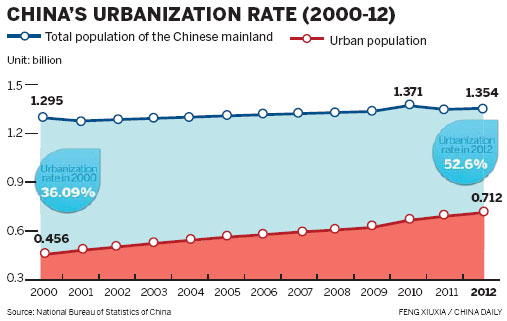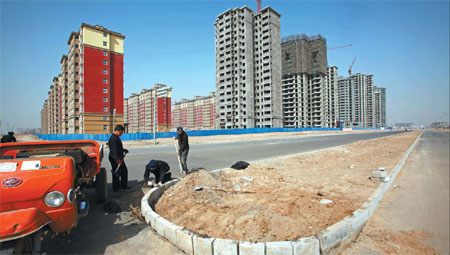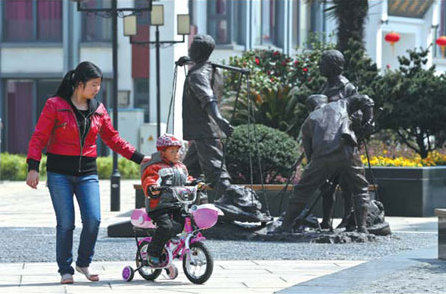Some still face question of identity
Updated: 2013-03-26 08:07
By Jiang Xueqing (China Daily)
|
||||||||
|
Above: A new residential area for farmers in Huaxian county, Henan province, is under construction. According to the local government, about 1.8 million farmers became city residents in the province by the end of 2012, pushing the urbanization rate up to 42.2 percent. Below: Yongliancun, once a poor village in Zhangjiagang city, Jiangsu province, has been built into a modern neighborhood community. Wang Zirui / for China Daily |
|
Yang Lei / Xinhua |

Migrant workers without proper registration unable to make themselves at home in the cities, Jiang Xueqing reports in Beijing.
Wang Jun, 46, came to Beijing from a small town in Fengyang county, Anhui province, in 1994. He opened a hair salon with his wife in a residential area in Dongcheng district and made around 40,000 yuan ($6,458) a year. Two years later, their son was born in the capital.
However, Wang's household is still registered in Anhui province. The family left their hometown long before China's social security system was launched and therefore has no right to social security or health insurance in either Beijing or Anhui.
As a result, they have to cover their medical expenses in full every time a family member goes to a hospital.
Wang's son attended primary and secondary schools in Beijing. But last year, at the age of 16, he had to return to Anhui and enroll at a local high school so he can take the gaokao, or college entrance exam, in 2015. Without a Beijing hukou, China's system of household registration, the young man is not allowed to take the exam in the city where he was born.
"I've been living here for almost 20 years, but I still don't feel like a Beijing resident," said Wang, who is now looking to the government to eliminate the policies that affect migrant workers and relieve the family's concerns about social security, health insurance and their child's education.
Those problems may well be answered soon. The central government is working on a national plan for urbanization, which is likely to be launched before the end of the first half of this year. One of the key ways of measuring the relative success or failure of the policy will be how well the government handles the task of ensuring that every citizen gains an equal share of the benefits of urbanization.
The plan aims to boost domestic demand and provide a guideline for the healthy and orderly development of urbanization, said Zhang Ping, then chairman of the National Development and Reform Commission, at a media briefing during the first session of the 12th National People's Congress in Beijing.
The government has introduced the strategy at a time when economic crises in Europe and the United States have caused a continuous decline in overseas demand for Chinese goods, and as the authorities seek a solution to the overcapacity that afflicts the manufacturing sector.
In the meantime, the migrant worker population hit 262.61 million in 2012, according to the National Bureau of Statistics. If such a large number of people were to be reclassified as city residents the subsequent upsurge in demand would be huge.
"Urbanization is the key to China maintaining economic growth and 'soft-land' its economy," said Wen Tiejun, dean of the school of agricultural economics and rural development at Renmin University of China.
Chi Fulin, president of the China Institute for Reform and Development, said urbanization will accelerate the transformation of the economy from an export-driven model to one based on domestic consumption. If successful, the move could sustain GDP growth of 7 to 8 percent in the coming decade.
Planners will encourage urban agglomeration, gradually reclassify migrant workers as urban residents and promote equal access to basic public services. They will also coordinate the development of different-sized cities and small towns, and increase the urban population capacity by strengthening the economy, infrastructure, natural resources and environments in the cities.
During this year's meetings of the National People's Congress and the Chinese People's Political Consultative Conference, local officials eagerly promoted the construction of city clusters, such as Chengdu-Chongqing in Southwest China, where large urban areas in close proximity employ increased collaboration between local governments, and combine the use of resources. Some of these clusters are huge; one example is the urban sprawl in the middle reaches of the Yangtze River where 40 cities, with a total combined area of nearly 440,000 square kilometers, house approximately 160 million people.
A convoluted history
The story of urbanization is long and convoluted and has suffered at least three major twists since the New China was founded in 1949.
During the First Five-Year Plan (1953-1957), China started 156 industrial construction projects with the aid of the former Soviet Union, and a large number of farmers swarmed to the cities. But in the early 1960s, many factories were closed or merged as a result of natural disasters and poor planning and policies, and the urbanization process suffered a major setback.
Another unexpected phenomenon was that of the "sent-down youth", when Chairman Mao Zedong ordered young city-dwelling intellectuals and recently graduated middle-school students to move to the countryside and "learn from the farmers".
The most recent setback occurred during the 2008-09 global financial crisis. As export orders fell sharply, many companies ceased, or partially suspended, production. At least 20 million migrant workers lost their jobs and returned to their home villages.
Urbanization was considered a major driving force for economic development and was listed as a national strategy in the 10th Five-Year Plan (2001-05), which emphasized that raising the levels of urbanization and boosting rural-urban migration would optimize the economic structure and create virtuous cycles of sustainable socioeconomic development.
The years 2000 to 2012 signaled one of urbanization's fastest development periods. The country had an urban population of 711.82 million by the end of 2012, rising from 455.94 million in 2000, according to the NBS. The urbanization rate - the proportion of people living in urban areas - increased to 52.6 percent from 36.09 percent during the period.
However, many government officials and experts said the rate was an overestimation, because the NBS considers migrant workers who have lived in a city for more than six months as part of the urban population. Although the method of calculation conforms to common international practice, the migrant workers - unlike urban residents - have no access to public services, including social security and health insurance.
Because at least a quarter of the urban population nationwide does not have access to these services, the actual urbanization rate is only 35 percent, said Chen Xiwen, deputy director of the Party's leading group on rural work. There is still a long way to go before China can achieve the 60 percent target rate by 2020, he added.
This is not simply a problem of statistical analysis, according to Chen. It means the government must provide restitution for a task it has not finished - that of making public administration and social security available to migrant workers - while it promotes urbanization during the next 10 years.
"The key for the successful reform of urbanization is the transformation of large-scale city expansion into people-oriented urbanization and making the term 'migrant worker' a part of history as soon as possible," said Chi of the China Institute for Reform and Development.
He suggested the government should gradually remove the restrictions on household registration, starting with small- and medium-sized towns before moving onto the big cities and eventually allowing the free movement of people, and centralized administration within eight years.
Evaluation system
On April 1, 2012, the Shenzhen municipal government issued an interim regulation that allowed migrant workers to obtain hukou via an evaluation system. Those who meet the basic requirements and have accumulated 100 points can apply through their employers or human resources agencies.
But the requirements and standards of evaluation are too demanding, said Zhang Xiaoshan, a senior researcher at the rural development institute of the Chinese Academy of Social Sciences.
For example, to be eligible to apply, a migrant worker must be 18 to 48 years old and hold a diploma from a high school or secondary technical school. They must also have a city residence permit, as distinct from hukou, and be entitled to social security. The workers will receive three points for each annual payment of endowment insurance, but the total number of points each person can accumulate through insurance payments is limited to 30.
Zhang suggested that local governments could set their own thresholds for migrant workers to apply for hukou, and he also called on the central government to clarify the application standards and link the urban pensions and health insurance systems with those in rural areas.
Land ownership
"During the latest round of urbanization, the government should start with confirmation of land ownership," said Zhang.
Local governments, especially those at city and county level, had been eyeing rural land collectively owned by farmers' groups for many years. The governments took over a large amount of collectively owned agricultural land in the name of public interest, but later sold it to real estate developers at market rates. However, the farmers received only minimal compensation.
According to the current Land Administration Law, compensation for farmland requisition, plus resettlement subsidies, should not exceed 30 times the land's average annual output value during the three years before expropriation. That results in farmers receiving less than 100 yuan for each square meter of farmland, said Jiang Ming'an, professor at the Peking University Law School during an interview with Beijing Times in November. It's little wonder they have cause for complaint, he added.
Zhang from CASS, said: "Land-based financing is unsustainable, especially since people's awareness of land protection has risen. At this point, the government should think of a lasting, sustainable, win-win mechanism that will allow cooperation between the farmers and the government, rather than playing a one-shot game."
"In the future, the country should standardize the procedures for land expropriation and guarantee the farmers' bargaining rights during the transfer of the rights to collectively owned rural land," said Chi of the China Institute for Reform and Development.
"Farmers whose land has been expropriated should be compensated in accordance with the market value of their land," he said.
Contact the writer at jiangxueqing@chinadaily.com.cn.
Yang Wanli and Peng Yining contributed to this story.

(China Daily 03/26/2013 page6)

 In Photos: 7.0-magnitude quake hits Sichuan
In Photos: 7.0-magnitude quake hits Sichuan
 Li Na on Time cover, makes influential 100 list
Li Na on Time cover, makes influential 100 list
 FBI releases photos of 2 Boston bombings suspects
FBI releases photos of 2 Boston bombings suspects
 World's wackiest hairstyles
World's wackiest hairstyles
 Sandstorms strike Northwest China
Sandstorms strike Northwest China
 Never-seen photos of Madonna on display
Never-seen photos of Madonna on display
 H7N9 outbreak linked to waterfowl migration
H7N9 outbreak linked to waterfowl migration
 Dozens feared dead in Texas plant blast
Dozens feared dead in Texas plant blast
Most Viewed
Editor's Picks

|

|

|

|

|

|
Today's Top News
Live report: 7.0-magnitude quake hits Sichuan, heavy casualties feared
Boston suspect cornered on boat
Cross-talk artist helps to spread the word
'Green' awareness levels drop in Beijing
Palace Museum spruces up
First couple on Time's list of most influential
H7N9 flu transmission studied
Trading channels 'need to broaden'
US Weekly

|

|









